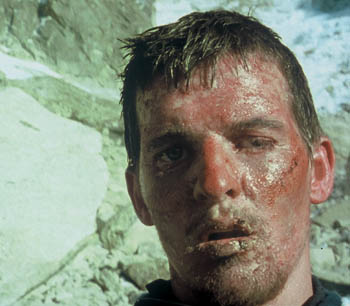![[Metroactive Movies]](/movies/gifs/movies468.gif)
[ Movies Index | Show Times | Silicon
Valley | Metroactive Home | Archives ]
Hell in the Andes: Brendan Mackey endures the
great south white in 'Touching the Void.'
Mountain Main 'Touching the Void'
chronicles a nerve-racking descent that tested two climbers to the limit By Richard von Busack
AMERICAN filmgoers are fascinated with the English,
especially the particular calmness they are supposed to muster in times of stress. Because of recent
movies, however, we are beginning to regard this coolheadedness as more myth than fact. The new-model
Brit is something of a Hugh Grant gabbler and ditherer. Now comes the mercilessly taut true-life thriller
Touching the Void, based on climber Joe Simpson's memoir. This excruciating story of a famous
mountaineering accident is directed by Kevin Macdonald, who did the equally gripping documentary about the
Munich hostage situation, One Day in September. The simple machinery of the movie winches the nerves.
Meanwhile, the matter-of-fact narration by Simpson and his climbing partner, Simon Yates, buys you some
breathing space. Recalling the sort of situation that would make most men start composing their last will
and testament, Simpson says, in the tone of a man who's missed a golf swing in a tournament, "Things were
seriously not going my way." The
climbers' account of their ordeal in the Andes reminds us of some cold facts. Sometimes, the decision to
save your life or to die on the spot is a choice made in tiny steps. Moreover, God doesn't necessarily lend a
helping hand when your life is on the line. (The film's vague title becomes clear in the scene of Simpson's
near-death delirium.) Having one's life in
one's hands isn't necessarily a grandly ego-boosting experience; it's agonizing and frightening.
Though this isn't in the movie, Yates noted that on his
return to the Andes, he was once again terrified by the mountain that almost killed him: "I had forgotten
just how appalling it was being reduced to almost nothing." In the Peruvian Andes in 1985, Simpson and Yates set out
to climb the still-virgin Siula Grande, a 21,000-foot peak. For the first part of the trek, Simpson (Brendan
Mackey) and Yates (Nicholas Aaron) face no unanticipated trouble. The two are Alpine climbers--no base
camps, backup supplies or sherpas. Getting to the top means slipping and slogging through a powdery snow
that has formed "cornices"--whipped-cream-colored mounds sculpted by the winds. On the way back down, something goes wrong. Simpson
plummets, driving his lower leg through his knee joint. The climbers, out of food, water and fuel, must inch
their way down the mountain. That's about the time the snowstorm returns. What Yates did to his partner in
the middle of that storm is still a matter of ethical debate among climbers. When Macdonald concentrates on Simpson's solo return to
earth, the film turns into an existential ordeal that's more like an Albert Camus story than
Cliffhanger. Simpson lies there, perishing of thirst, freezing on the rocks, with those strange
Southern Hemisphere constellations wheeling overhead, in what kind of pain sympathetic viewers can all too
easily imagine. At this moment, is
Simpson feeling the unity of all things, the presence of a Great Unknown that wants him to live? Not at
all--in fact, he's tormented by an awful Boney M. song that he can't stop from buzzing in his head. This may
be heroism, but it's also the human condition. Half the movie takes place in close-up: Simpson and Yates, whose demeanor and ever-polite voices
are like a pair of characters in a Wallace and Grommit cartoon, comment on the footage of the climb, which
is mostly silent (except for the occasional cries for help). But we cut to Yates' camp at a lake, where he
recovers from the climb at the foot of this Murderhorn. Aaron's Yates looks like a man with a fresh case of
leprosy: he's clown-faced from severe wind and sunburn, with a few fingers black from frostbite.
But the film also goes wide, forsaking the
satisfying microshots of steel screws biting into the ice or nylon ropes inching through Prosset loops. This
ominous mountain, which most sensible people would be happier getting to know through a postcard, is a
character, too. The camera detects the climbers, little beads of white on the edge of a rock, ants amid the
Rorschach-test maze of ice crevices. Touching the Void is about the kind of remote annihilation that
makes drowning in the ocean look like dying in bed. Strangely, the film has a happy ending, with the sunlike
glow of candlelight through an orange nylon tent. Perhaps an even greater happiness is that a producer
named Sally Field and an actor named Tom Cruise didn't adapt this book as they proposed to do at one point.
The film is as honorable as it is thrilling. It has moments of grandeur, but its focus is small and knife-sharp.
You can ask no more from an adventure film than to have it be a brutal subject told by sensitive people.
[ Silicon Valley | Metroactive Home | Archives ]
Copyright 1994-2025 Weeklys. This page is part of Metro Silicon Valley's historical archive and is no longer updated. It may contain outdated information or links. For currently information, please go to MetroSiliconValley.com home page, e-edition or events calendar.
![]()

Photograph by FilmFour Ltd.
Touching the Void (Unrated; 106 min.),
directed by Kevin Macdonald, written by Macdonald and Joe Simpson, photographed by Mike Eley and Keith
Partridge and starring Brendan Mackey and Nicholas Aaron, opens Friday at selected theaters.
Send a letter to the editor about this story to letters@metronews.com.
From the February 12-18, 2004 issue of Metro, Silicon
Valley's Weekly Newspaper.